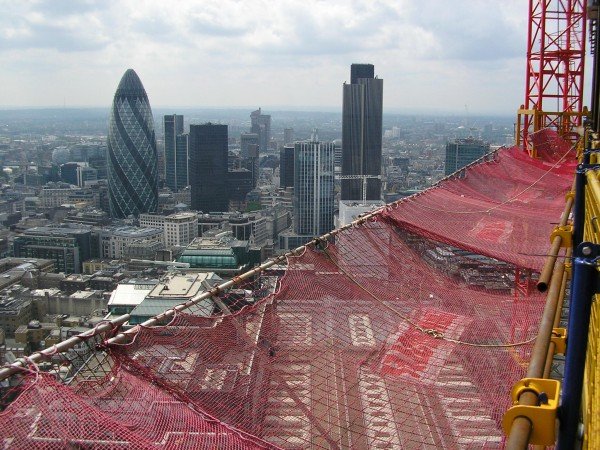Working at height: 40 years of progress part 4

The use of perimeter netting – ‘fans’ – to protect against falling objects. Photo credit: David Thomas
Working from height remains one of the biggest causes of fatalities and major injuries in the UK. In the fourth and final part of his four-part series, David Thomas reflects on 40 years of progress.
A review of equipment and techniques is available in A technical guide to the selection and use of fall prevention and fall arrest equipment [2005]. [1] The report describes and assesses equipment and method of fall protection, in particular purlin trolley systems, safety decking, fall arrest mats, safety netting, cable and track-based fall arrest systems and scaffolding. [2] This report would be usefully updated.
Ladders
HSE [3,4] has gone to great lengths to state, “… We have not banned stepladders – nor have we banned ladders… the allegation is regularly repeated and some firms have fallen for the myth and acted upon it…”.
The health and safety watchdog’s Topic inspection pack: Falls from height [5] states that, “…The main cause of all injuries from falls from height is people falling from ladders…”. It goes on to say, “…Ladders are ubiquitous and are often used unsupervised as a means of access to high workplaces and also as a place of work. All too often, ladders are used without thought given to whether they are the safest equipment for the job. They are often treated with complacency…”.
While the Work at Height Regulations doesn’t ban ladders, it does require that they should be used only when all other safer alternatives for work at height have been ruled out. A risk assessment must show that the task is low risk and of short duration, or that there are site features that mean other equipment is not appropriate. If this is so, then ladders can be used.
After the introduction of the Work at Height Regulations the ‘banning of ladders’ was, perhaps, the one ‘that nearly got away’. There appeared to be a ‘fear of the unknown’, e.g. in how the regulations would be enforced, and there was also an over-zealous reaction by some in banning ladders on their sites. While well-intentioned this resulted, in my opinion, from an uncertainty about the best means of addressing what might be termed short duration and/or low risk work; and a lack of consistency and approach between inspectors.
Ladder classes are considered in BS 2037, BS 1129 and BS EN 131. Work is underway to revise and improve the latter, following a European Commission mandate [6], although I have yet to see evidence that the issue of stability has been addressed in a way that is equivalent to, or better then, the stability performance recommended in Research Report 205. [7] OC 200/30 [8], states, “… HSE’s current position is that, for a stability device or a leaning ladder to be effective as a freestanding device it should be capable of withstanding the forces established in Research Report 205…”.
Safety netting
Safety netting provides a collective and passive protection system, used to save lives and reduce injuries by absorbing energy from a falling person. Rigged to the underside of a structure, they are normally used as the fall protection (and are best rigged at close proximity to the working level, thus minimising the distance of any fall as well as the consequences).
Safety nets were mentioned first in the Construction (Working Places) Regulations 1966, [9] becoming more widespread in use, indeed the ‘norm’, in the mid-1990s as a result of the Construction (Health, Safety and Welfare) Regulations 1996; as well as the update in 1998 of HSG33 [10] when safety netting was promoted as a major contributor to height safety within industrial, commercial, domestic new build and refurbishment building projects; with nets in place for much of the construction programme.
While information on reportable injuries is available there is little historical information on the number of times people have entered nets without suffering significant injury. Anecdotally, though, safety netting is reported to have saved many injuries and, with the training, assessment and standards established by FASET [11], there is little doubting its effectiveness as an effective control measure.
Conclusion
To conclude, while much has been achieved over the last 40 years to improve working from height more still needs to be done. Indeed, those who work at height should never forget that gravity is no respecter of persons – gravity sucks.
David Thomas is technical director at The heightec Group Ltd and is also a director of Heightsayfe Ltd.
References:
- HSE Research Report 302
- SG4:00: The use of fall arrest equipment when erecting, altering and dismantling scaffold, NASC (now SG4:10)
- www.hse.gov.uk/myth/april.htm (Accessed 5 September 2015)
- www.hse.gov.uk/press/2005/e05110.htm (Accessed 5 September 2015)
- www.hse.gov.uk/foi/internalops/fod/inspect/falls.pdf (Accessed 5 September 2015)
- European Commission, DG XXIV, Consumer Policy and Consumer Health Protection, Directorate A – Consumer Policy, Unit A4 – Consumer Safety and Environment, Doc. 43/99, Ladders
- Evaluating the performance and effectiveness of ladder stability devices, Research Report 205, HSE: www.hse.gov.uk/research/rrhtm/rr205.htm (Accessed 5 September 2015)
- OC 200/30, Safe use of ladders and stepladders, www.hse.gov.uk/foi/internalops/ocs/200-299/200_30/index.htm (Accessed 5 September 2015)
- Regulation 38, Prevention of falls and provision of safety nets and belts
- HSG33, Health and safety in roof work, HSE
- Fall arrest safety nets, Protecting people when working at height: www.faset.org.uk/docs/safetynet.pdf (Accessed 5 September 2015)
Working at height: 40 years of progress part 4
Working from height remains one of the biggest causes of fatalities and major injuries in the UK. In the fourth
Safety & Health Practitioner
SHP - Health and Safety News, Legislation, PPE, CPD and Resources Related Topics
Indian manufacturing plant scoops fall prevention award
Workers facing uncertain future coupled with health and safety risks, new IOSH report says
Legionella Management: Who can be appointed as RP, DRP, AP or CP?

